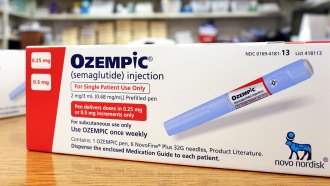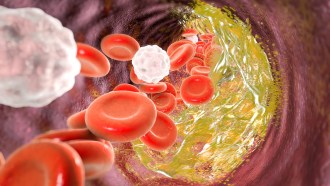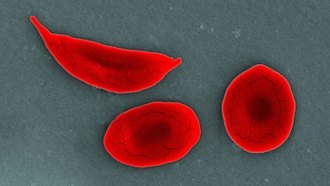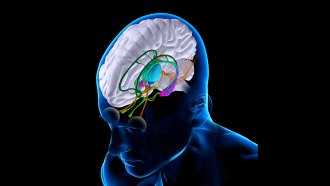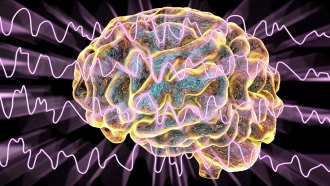Fetuses make a protein that causes morning sickness in pregnancy
Desensitizing people to the protein before pregnancy or blocking its action may help

Nausea and vomiting are common during pregnancy. Researchers have found a major driver of the illness, which can sometimes be severe enough to require hospitalization.
bymuratdeniz/E+/Getty Images
A surge of a hormone made by fetuses triggers the stomach-turning nausea and vomiting of morning sickness, a new study suggests.
People who have naturally low levels of the protein in their blood before pregnancy are more susceptible to a severe form of morning sickness called hyperemesis gravidarum when hit with the rush of protein, researchers report December 13 in Nature. The findings could help identify people at risk of the severe illness and lead to treatments.
Up to 80 percent of pregnant people get nauseous in the early stages of pregnancy, and about half vomit — a combo of symptoms often called (misleadingly) morning sickness. A small percentage of pregnant people — up to 3 percent — will develop hyperemesis gravidarum, vomiting so severe and frequent it can lead to weight loss, dehydration and even hospitalization and death of the fetus or mother.
Previously, researchers speculated morning sickness is caused by estrogen or other hormones that are elevated early in pregnancy, says gynecologist and obstetrician Jone Trovik, who was not involved in the study. For severe sickness, she says, studies implicated elevated thyroid hormone, infections and other causes.
“Most problematic has been that it has been considered to be a psychological cause, which has been widely refuted,” says Trovik, of Haukeland University hospital and the University of Bergen in Norway. “Women have been told, ‘Maybe you don’t want this pregnancy. Maybe you’re angry with your husband.’”
The new findings, Trovik says, provide “evidence that this is a real disease.”
Patients who had nausea and vomiting during pregnancy had higher levels of a protein called GDF15 in their blood than pregnant people without the symptoms, endocrinologist Stephen O’Rahilly of Cambridge University and colleagues report. That protein, which is made throughout the body and helps cells respond to stress, was previously found to act on a part of the brain involved in producing nausea and vomiting.
Study coauthor Marlena Fejzo and colleagues had already shown that people with a certain genetic variant in the GDF15 gene have up to 10 times the risk of developing hyperemesis gravidarum than people without the variant. But those with the variant produce less GDF15 than is typical, those researchers discovered.
That finding was a conundrum, says Fejzo, a geneticist and hyperemesis gravidarum researcher at the Keck School of Medicine of USC in Los Angeles. If people with the variant produce low levels of GDF15, but high levels are associated with nausea and vomiting, why is the variant a risk for severe morning sickness?
Turns out that people with the risk variant make less of the protein before pregnancy, but have elevated levels of GDF15 in their blood when pregnant. The twist is that most of the GDF15 produced in pregnancy comes from the fetus and placenta, the study’s researchers found. People with the risk variant aren’t used to GDF15’s sick-making effects. “So when you’re met with those high levels in early pregnancy, you’re highly sensitive to them, more than the average person,” Fejzo says.
Conversely, people with a rare blood disorder called beta thalassemia have high levels of GDF15. Those people rarely get queasy during pregnancy, the researchers found. That finding suggested that exposure to the protein before pregnancy might desensitize people so they don’t become so sick.
The team tested the idea in mice. Rodents that got a big dose of the protein cut back on eating, something the animals typically do when nauseous. But if the mice got prepped for the surge with a lesser dose of long-acting GDF15 three days beforehand, they weren’t bothered as much. The result suggests that small amounts of the protein can blunt the effect of a bigger dose later.
All the findings together also suggest avenues for treatment. The diabetes drug metformin raises GDF15 levels and might be given to people at risk of hyperemesis gravidarum before pregnancy, O’Rahilly says. Or, future drugs may be developed to block the action of GDF15 on the brain.
Fejzo notes one caveat, though: Most of the genetic studies were done with people of European descent, so it’s not certain that GDF15 is a major player for all ethnic groups.
Also, gastroenterologist Sumona Saha says that before any treatment can be given, researchers will need plenty of safety data from animal studies (SN: 4/21/22). No one really knows what effect blocking GDF15 may have on fetal development or if raising levels of the protein before pregnancy could affect conception, says Saha, of the University of Wisconsin School of Medicine and Public Health in Madison.
Currently, doctors try a variety of antinausea medications, neurological drugs and other therapies, sometimes including intravenous fluids and nutrition to treat people with severe nausea and vomiting. Having therapies focused on GDF15 may improve treatment, Saha says.
“We’ve got, potentially, a very targeted therapy versus a lot of other treatments, which are like taking a hammer to a problem. Now, we potentially will have an X-Acto knife that we can use.”


